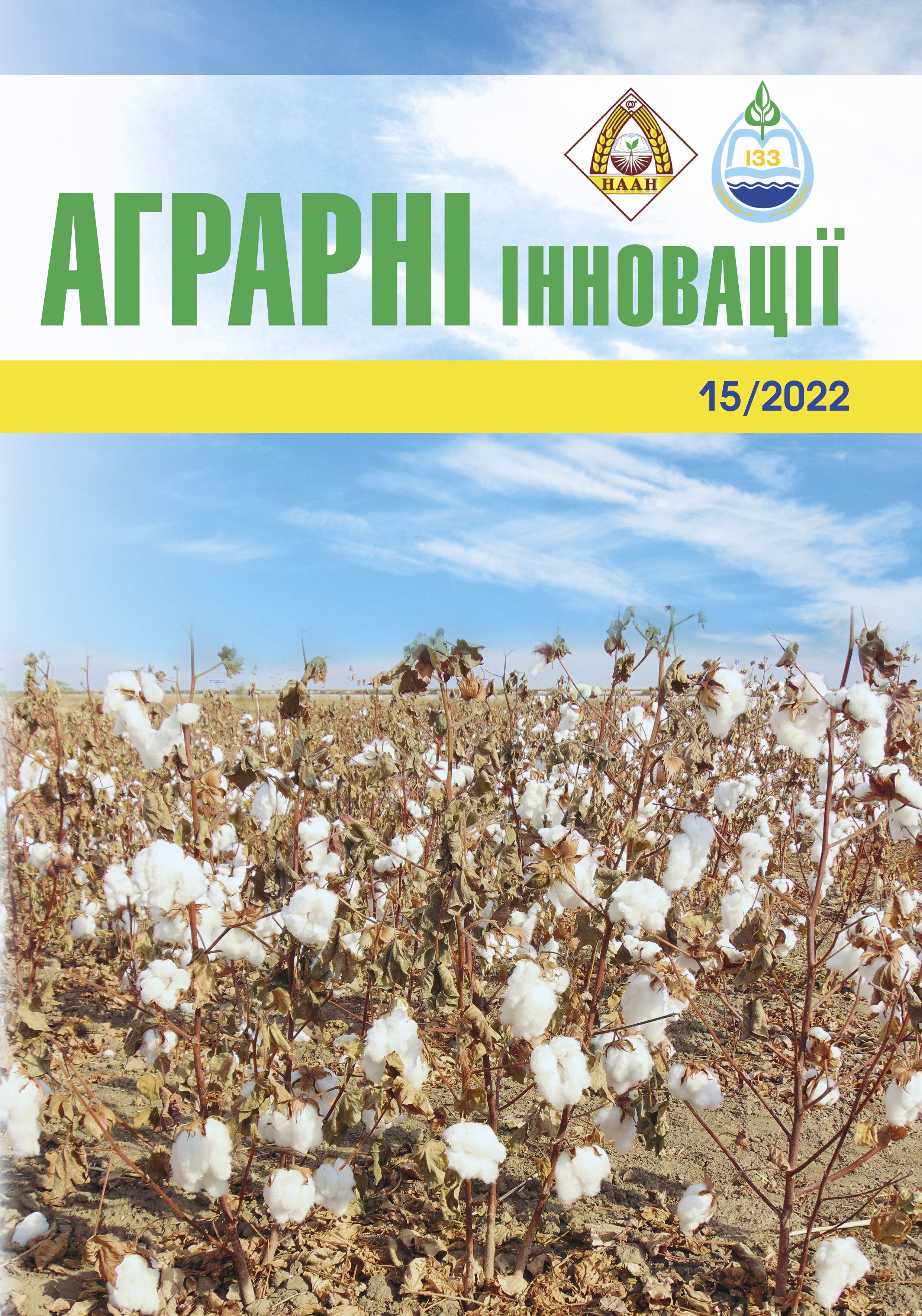The influence of growth stimulants on the rooting of narrow-leaved lavender for garden and park cultivation
Abstract
Goal. The purpose of our research was to study theeffect of growth stimulants on the rooting of narrow-leavedlavender cuttings of Mriya and Record, Elizabeth varieties.Methods. The vegetative research method involveddetermining the effect of different concentrations of growthstimulants on the rooting of green cuttings of narrow-leavedlavender varieties. The research material was green cuttingsof narrow-leaved lavender varieties Mriya and Record,Elizabeth. In each variant, 25 cuttings were evaluated in4 repetitions. The number of rooted cuttings was determinedon the 30 th and 45 th day, taking into account signs ofrooting. With the help of the statistical method by meansof dispersion analysis, the smallest significant differenceaccording to this indicator was established. Research wasconducted during 2021-2022 in greenhouse conditions.Research results. The rate of rooting of green cuttings,depending on the variety, duration of rooting, growthstimulator and its concentration, varied from 53% to 91%.The coefficient of variation was 13.4%, which indicatesthe average degree of variation of this characteristic. The highest rooting rate (91%) in the experiment wasdistinguished by the cuttings in the version with the use of'1R Seed treatment' at a drug concentration of 0.25 g/l inthe Elizabeth variety, and the lowest in the control versionof the Mriya variety (53%). According to average data, thehighest yield of cuttings was noted in variants with theapplication of '1R Seed treatment'. Green cuttings of theRecord variety are noted for their better generating capacity.At different concentrations of the researched growthstimulants, a significant difference between the variantswas noted. The best rooting results for the preparation'Foliar Concentrate' were at a concentration of 0.35 g/l,compared to the control version, the percentage of rootingwas 21.6% higher. Under the conditions of application of'1R Seed treatment', the rooting rate was the highest at aconcentration of 0.25 (by 24.2% more compared to thecontrol). During the application of succinic acid, an 18.2%increase in the rooting of cuttings was noted compared tothe control at a concentration of 0.35 g/l.Conclusions. It was established that in order to ensurehigh regeneration of green cuttings of the researchednarrow-leaved lavender varieties, it is necessary to use thefollowing concentrations: for '1R Seed treatment' – 0.25 g/l,'Foliar Concentrate' and succinic acid – 0.35 g/l.
References
2. Єжов В. М., Рудник-Іващенко О. І., Шобат Д. М., Ярута О. Я. Науково-організаційні та економічні аспекти вирощування лікарських і ефіроолійних культур в Україні. Вісник аграрної науки. К., 2014. № 11. С. 16-21
3. Nicola, S., Fontana, E., & Hoeberechts, J. (2002, March). Effects of rooting products on medicinal and aromatic plant cuttings. In VI International Symposium on Protected Cultivation in Mild Winter Climate: Product and Process Innovation 614 (pp. 273-278).
4. Рудник-Іващенко О. І., Кременчук Р. І. Біологічні особливості рослин лаванди за насіннєвого способу розмноження у Лісостеповій зоні України. Наукові доповіді НУБіП України. №4 (74). 2018. С. 1-14
5. O. Markovska, L. Svidenko, I. Stetsenko (2020). Comparative assessment of morphometric features and agronomic characteristics of Lavandula angustifolia Mill. and Lavandula hybrida Rev. Scientific Horizons, 02 (87), 24–31. doi: 10.33249/2663-2144-2020-87-02-24-31.
6. Mahmoud, M. K., & Mohaned, M. A. E. B. (2014). A comparative study to improve rooting of English lavender stems cuttings. African Journal of Agricultural Research, 9(50), 3632-3637.
7. Рекомендації по застосуванню регулятора росту рослин Чаркору для розмноження ягідних, плодових та декоративних культур. НАН України. К. : 2002. С. 10–12.
8. Кременчук Р. І. Вплив стимуляторів росту на ризогенез живців лаванди вузьколистої (Lavandula аngustifolia). Міжвідомчий тематичний збірник Садівництво. 2017. Київ, № 72. С. 172-178.
9. Ящук В. У., Корецький А. П., Ковбасенко Р. В., Дмитрієв О. П., Ковбасенко В. М. Гумінові речовини – безпечні регулятори екосистем. К.: , 2016. 88 с.
10. Баган А. В., Юрченко С. О., Шакалій С. М. Формування посівних якостей насіння зернобобових культур залежно від стимулятора росту Foliar Concentrate. Таврійський науковий вісник. 2020. № 113. С. 3–9. DOI: https://doi.org/10.32851/2226-0099.2020.113.1
11. Юрченко С. О., Баган А. В., Омелич М. В. Формування посівних якостей насіння сортів арахісу залежно від обробки стимулятором росту “1R Seed Treatment”. Таврійський науковий вісник. 2021. № 117. С. 164–171. DOI: https://doi.org/10.32851/2226-0099.2021.117.22
12. Маренич М. М. Ефективність способів застосування гумінових стимуляторів в технології вирощування пшениці озимої. Вісник ПДАА. 2019. № 3. С. 26-34.
13. Методичні рекомендації з розмноження деревних декоративних рослин Ботанічного саду НУБіП України. К. : 2008. С. 17-19.
14. Доспехов Б. А. Методика полевого опыта. М. : Агропромиздат, 1985. 351с.






